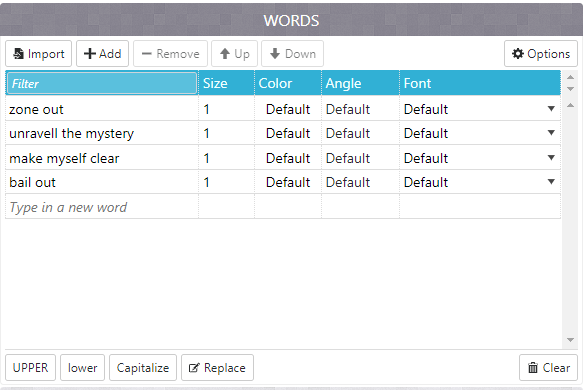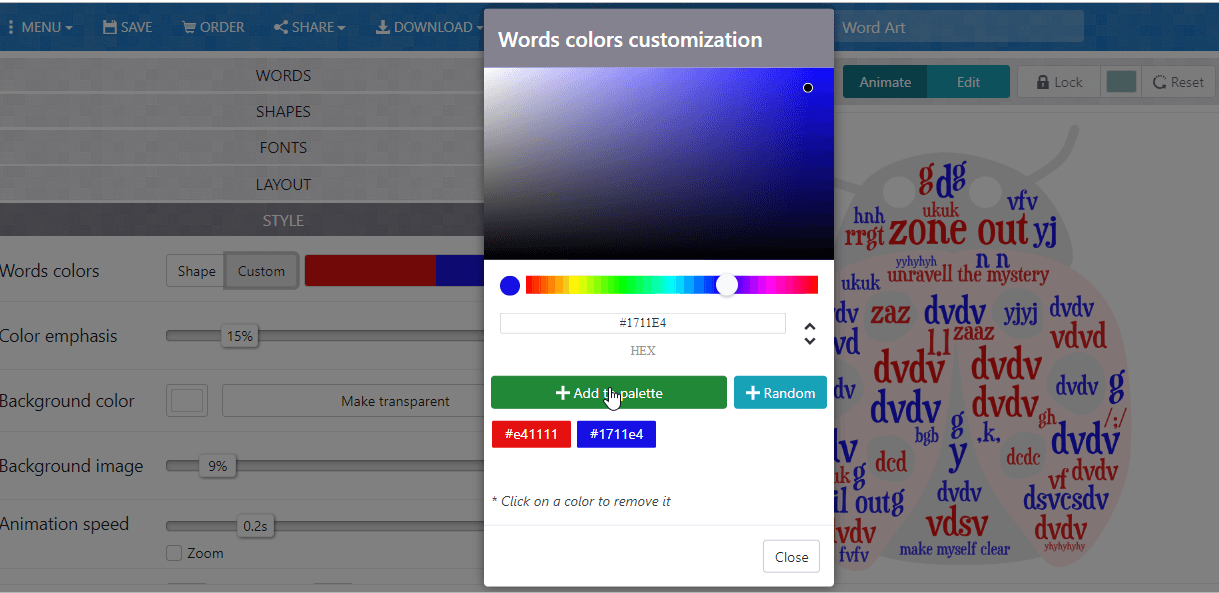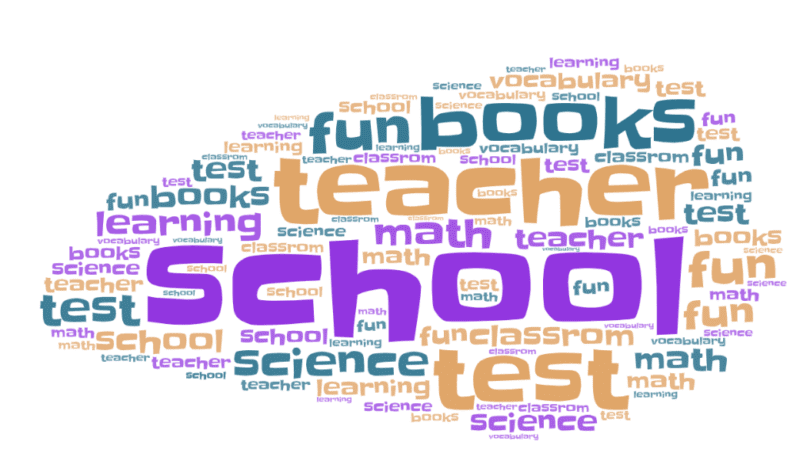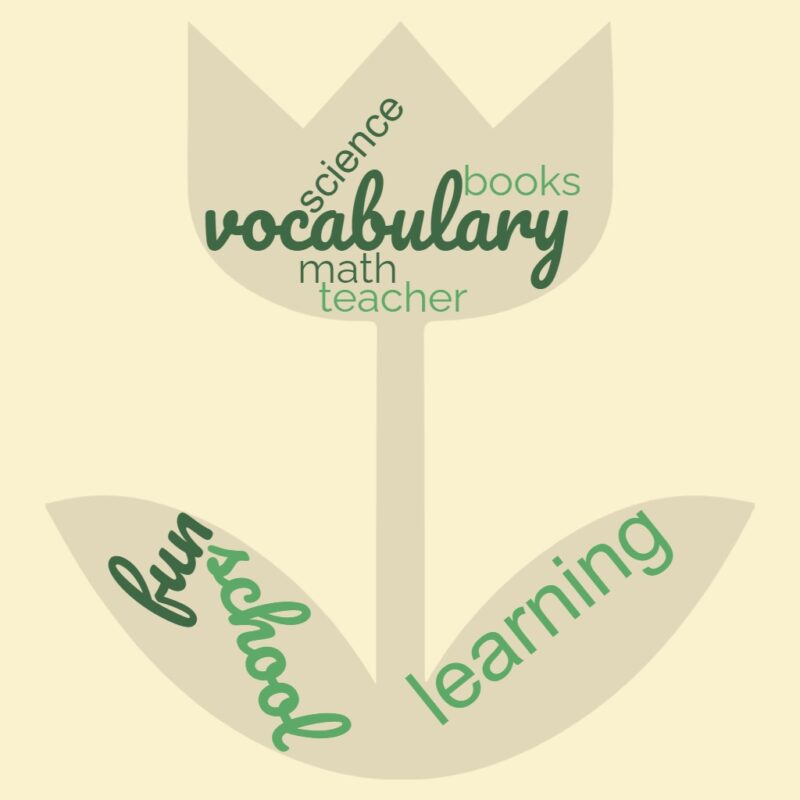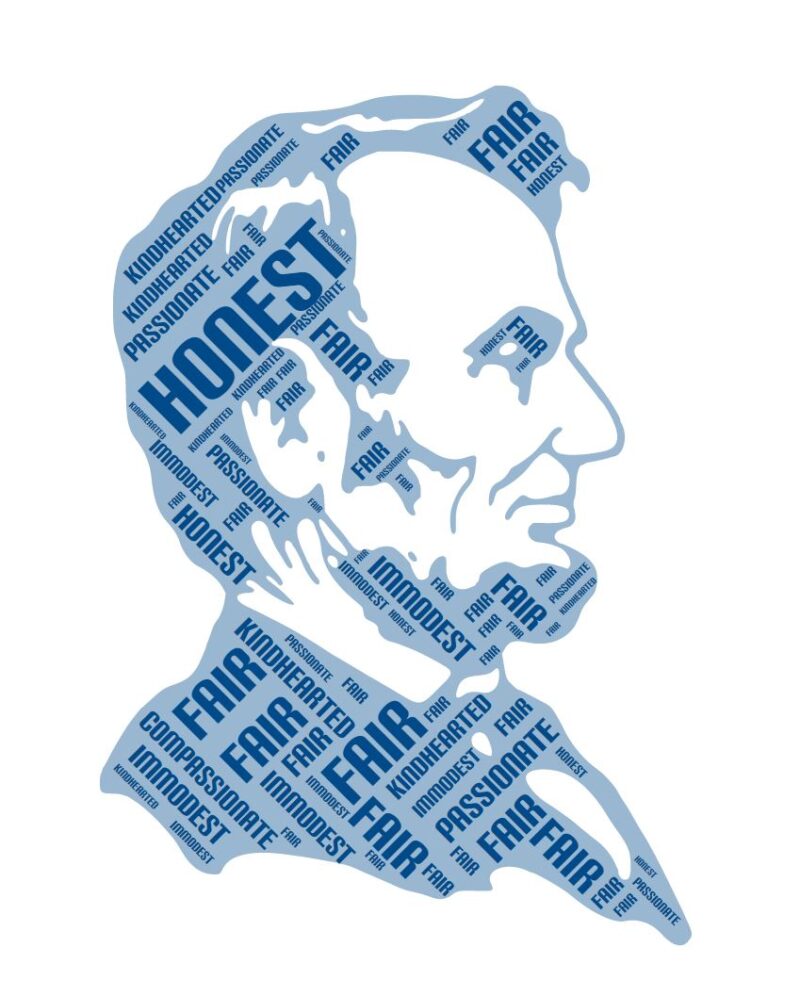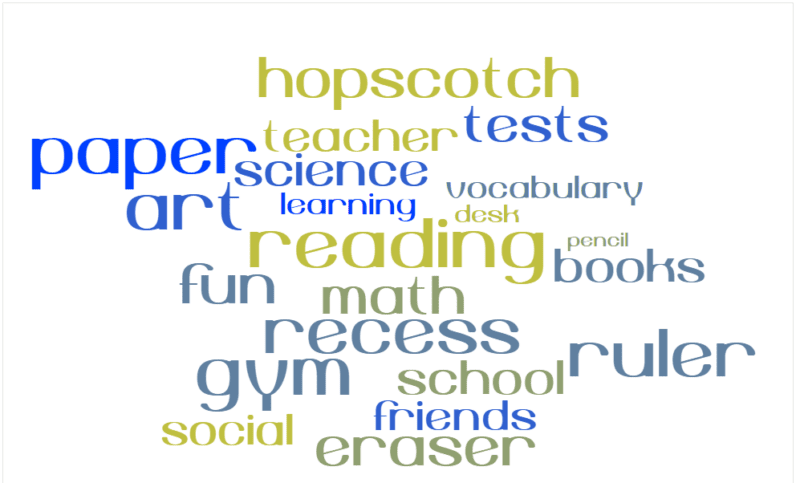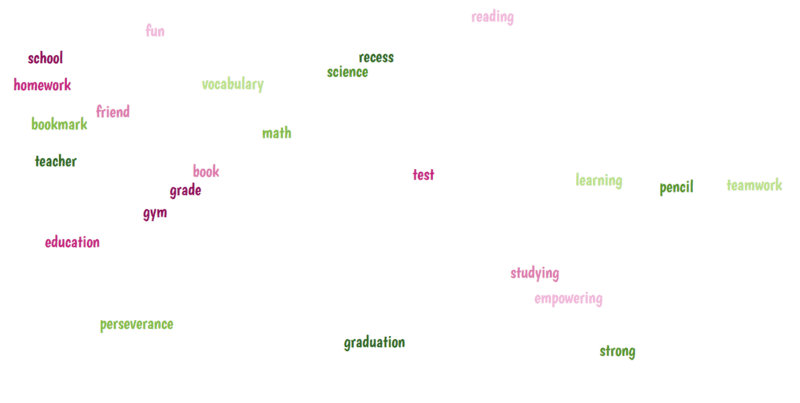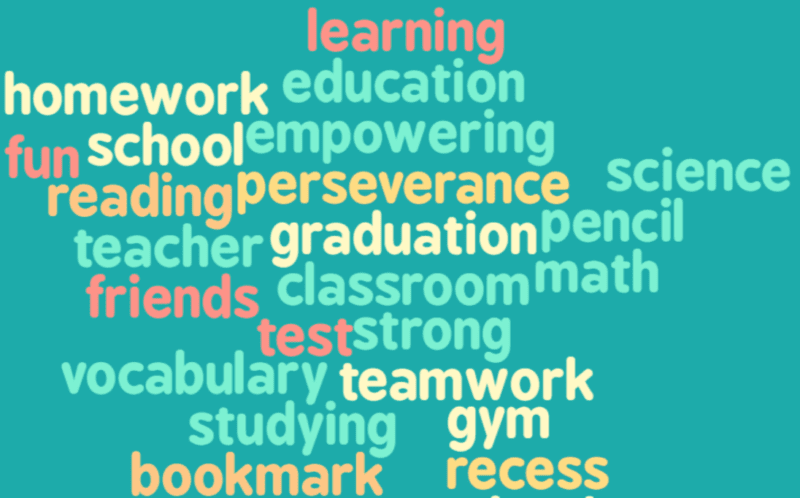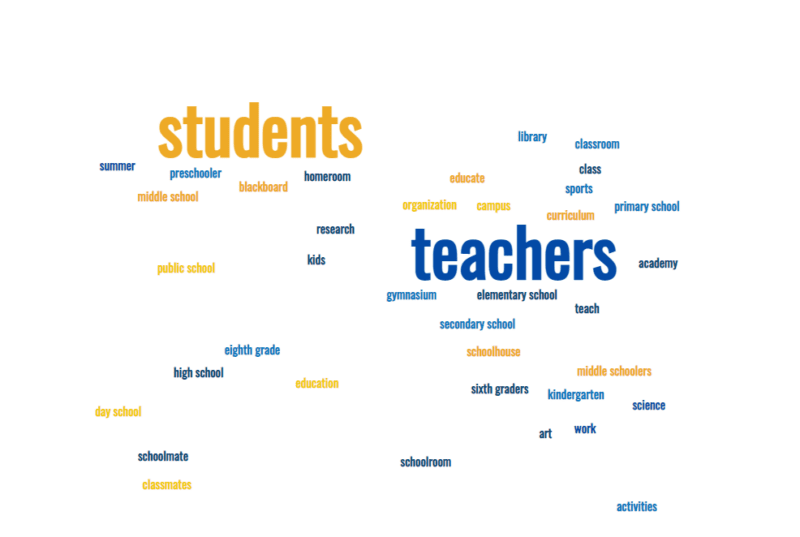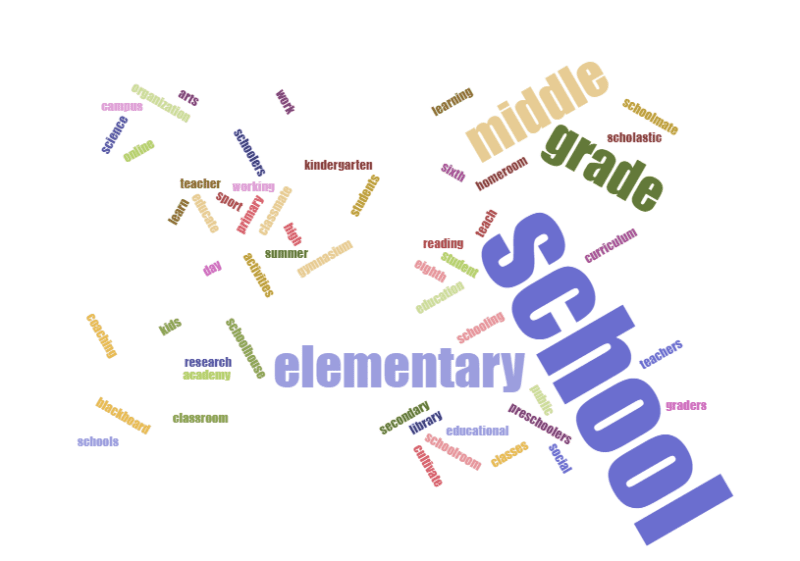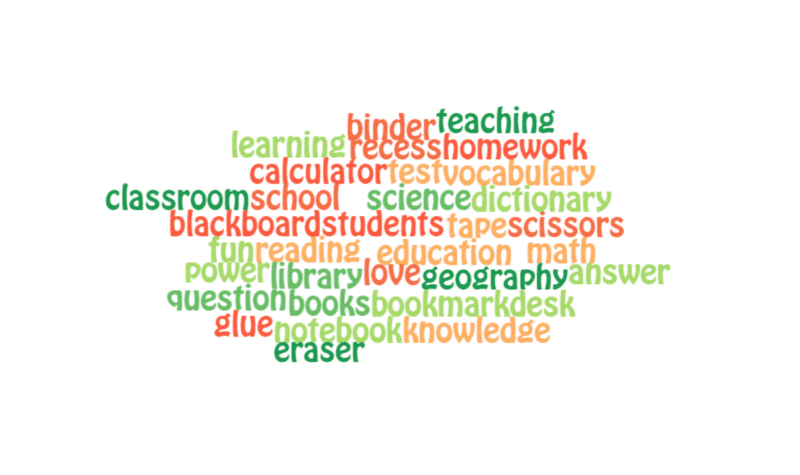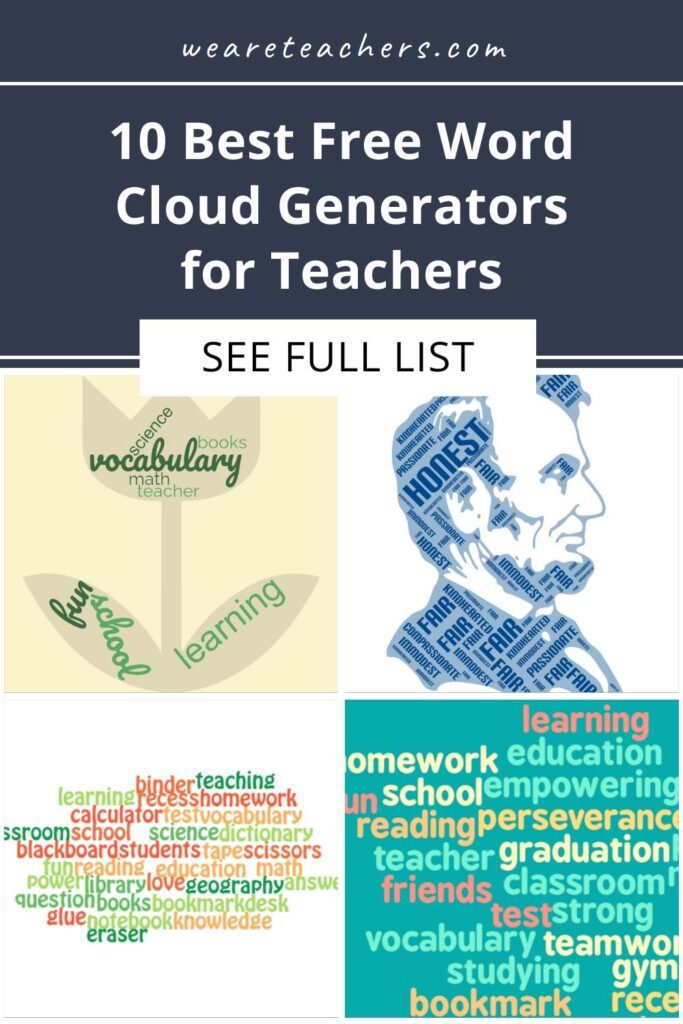Variety and novelty in English lessons encourage learners to be more engaged. On the contrary, monotonous tasks, no matter how useful they are, cause boredom. How to bring variety without too many changes in the process of learning vocabulary? Use word clouds.
Word clouds are a graphical representation of words and words combinations. They can be used for:
- vocabulary revision
- presenting lexis
- practicing new words
- student’s projects.
It is just a more visually appealing way to teach vocabulary. Instead of using lists, which students are probably fed up with, make clouds. You can utilize them for word searches, making monologues and dialogues, word games, writing tasks, etc.
Here are some examples of the tasks.
Task 1
Make a story about a detective investigating a case using all the words and tell your partner (the teacher).
Task 2
Work in pairs. Ask and answer five questions using the words.
Task 3
Give a definition of one of the words. Can your partner guess the word? Swap roles.
There are some services for creating word clouds:
Word Art
Wordle
Word clouds
I personally prefer to use Word art because it’s possible to create clouds containing collocations. As we know teaching collocations is more effective for learners. Other services just break the word pairs into single words.
Let’s see how to create word clouds using Word art. It’s quick and easy, no registration is required. So click ‘Create’ and make your cloud.
Step 1
Fill in the words or word combinations. You can type as many words as you need, even 30 or even 50. It’s possible to Capitalize letters, use the UPPER or lower case. Click ‘Options’ and opt for repetition of the words as you see in one of the pictures above or choose no repetition.
Step 2
Choose the shape of your cloud: animals, nature, people or some holidays themes. If you want to see the changes, click the red button ‘Visualize’.
For example, this charming ladybird will definitely catch kids’ interest.
 Step 3
Step 3
Choose a font which you like. There are more than 50 fonts to select.
Step 4
Pick out a layout: horizontal, vertical, crossing words, dancing words, slopes and random. The layout will depend on the task and the learners. Teens prefer something less ordinal and more creative. For adults, I usually make more conservative things like a horizontal layout.
Step 5
Choose a style: colours of the words and the background. If you want to change a colour of the words, click ‘Words colours’ and ‘Custom’ and add more colours to the pallette.
Step 6
To apply all the changes, press ‘Print’ or ‘Download’ your cloud and enjoy it in your lessons.
The Value of Our Free Word Cloud Generator
Speak’s AI word cloud generator uses machine learning and artificial intelligence to reveal insights, help with writer’s block, be a root as an AI content generator and more.
Word clouds are a great way to highlight the most important words, topics and phrases in a text passage based on frequency and relevance. Generate word clouds from your text data to create an easily understood visual breakdown for deeper analysis. Use our free word cloud generator below!
Speak’s online tool demo is the best free word cloud generator that can serve as your word cloud maker, allowing you to get a word cloud online and be a great tool for brainstorming word clouds so that you can present meaningful visualizations.
More than a free word cloud creator or a basic word cloud, Speak can generate clickable word clouds. Speak makes word cloud creation instant so you can make your own word cloud, word cloud art, tag cloud, Twitter word cloud generator or other variations of keyword cloud generators to drive value and understanding for stakeholders. You can even create a free wordle generator! The possibilities are endless with a word cloud creator free of risk and technical difficulties.
You can also check out how to transcribe a YouTube video to effortlessly bring valuable video content into Speak for transcription and analysis so that you can produce free word cloud generation.
What Is A Word Cloud?
Word clouds, also known as tag clouds, are visual representations of text data. They are used to provide insight into the structure, content, and meaning of a text by displaying the most frequently used words in the text.
What Data Is Good For Word Clouds?
Drop your text, call transcripts, customer reviews, blog content, website copy and more and instantly see brands, locations, numbers, events, products and more visualized. With a Speak account, you can add custom keywords and phrases that will also appear in your visualizations!
What Is The Purpose Of A Word Cloud?
This information can be useful for a variety of purposes, from market research to data analysis.
Words clouds are often used to explore relationships between words and phrases, allowing users to quickly gain an understanding of the text. For example, word clouds can be used to compare the language used in different files, identify the most frequently used words in a particular text, or uncover the meaning of a text by displaying the words in a visually appealing way.
The purpose of word clouds is to quickly convey information. By displaying the most frequently used words in a text, they can help to identify the main themes and topics of the text. This makes them a useful tool for market research, as they can help to identify the main topics that customers are interested in, as well as the language they use to talk about those topics.
Word clouds can also be used to compare multiple texts, audio files, video files and other types of unstructured language data media. Comparing the words used in each text can help to identify the similarities and differences between them. This can be useful for data analysis, as it can help to identify patterns and trends in the data.
Word clouds can also be used to help to get an understanding of the general sentiment of the text. For example, media full of negative words might imply a negative sentiment, while media with more positive words might imply a positive sentiment.
Word clouds can also be a useful tool for search engine optimization. Displaying the most important words and recurring words used in media can give you ideas and help you optimize your content for search engines.
Who Uses Word Clouds?
Word clouds are a popular tool for businesses of all sizes to visualize large amounts of data in a visually pleasing way. Word clouds are used by businesses to gain insights from customer feedback, surveys, and other sources of data. They are used to provide an overall picture of how customers feel about a product, service, or company.
Word clouds are used by small and medium-sized businesses, marketing agencies, market research firms, organizations with 51 to 1,000 employees, marketers, qualitative researchers, customer experience managers, market researchers, product researchers, SEO specialists, business analysts, data scientists, academic researchers, business owners and more.
Small & Medium Sized Businesses
Small and medium-sized businesses can use word clouds to gain insight into customer feedback and to get an overall picture of how customers feel about their product or service.
Word clouds can help small businesses gain a better understanding of the customer’s needs and wants, as well as what they are looking for in terms of product or service offerings. This understanding can be used to create better marketing campaigns and to help the business better understand its customer base.
Marketing Agencies
Marketing agencies can use word clouds to help them create more targeted campaigns. By understanding the customer’s needs and wants, marketing agencies can create campaigns that are more likely to resonate with the customer. Word clouds can also help marketing agencies identify the most popular words and phrases associated with a business or product, which can help them create more effective campaigns.
Market Research Firms
Market research firms can use word clouds to gain insights into customer feedback and to get a better understanding of customer sentiment. By understanding the customer’s needs and wants, market research firms can create better surveys and polls to gain more accurate feedback. Word clouds can also help market research firms identify the most common words and phrases associated with a business or product, which can help them create more effective surveys and polls.
Advantages And Disadvantages Of Word Clouds
It is also worthwhile to explore the advantages and disadvantages of using word clouds to visualize data. We’ll look at why they are useful for business owners and professionals, and how they can be detrimental if not used correctly. After reading this article, you should have a better understanding of what word clouds can do and how to best use them for your business needs.
Advantages of Word Clouds
Easily Interpretable
Word clouds make complex data more easily interpretable by transforming it into an eye-catching visual that can be understood by even those who aren’t familiar with interpreting data reports. This makes it easier for customers and business owners alike to identify trends within their data sets quickly and accurately.
Quickly Identify Keywords
By filtering out unnecessary words and displaying only the most common terms in a visually appealing manner, word clouds allow users to quickly identify keywords that are relevant to their search query or project objectives.
Creates Aesthetic Visuals
Word clouds are an aesthetically pleasing way to present data in a way that looks visually appealing without sacrificing accuracy or readability. This makes them great for presentations or online content that requires visual appeal for maximum impact on viewers.
Affordable & Easy To Set Up
Setting up a word cloud is relatively easy and affordable compared to other types of data visualization tools. Many online tools allow users to quickly set up word clouds with minimal effort required, making them ideal for those who don’t want to invest too much time or money into creating visuals from their data sets.
Disadvantages of Word Clouds
May Not Be Accurate Representation Of Data
While word clouds do provide an aesthetically pleasing representation of selected terms within a given data set, they cannot accurately represent the full scope of the information contained within it due to their simplified nature – meaning that any conclusions drawn from these visuals should be taken with a grain of salt until confirmed by further analysis.
Reduced Readability
Since the sizes of words displayed in a word cloud are determined by frequency rather than grammar rules, it can be difficult for readers to parse out individual words without enough context surrounding them which can lead to difficulties in understanding what is being presented – particularly when trying to spot patterns within dense data sets with multiple terms involved.
Not Customizable Enough For Complex Projects
Although word clouds are great for quickly presenting basic information in an attractive visual format, they may not be detailed enough when working on more complex projects as there aren’t many options available when it comes to customization or formatting features offered with most available services or software programs – like changing colours/backgrounds/fonts etc., which could limit its effectiveness depending on the type project being worked on or result desired from the visualization process.
What Is The Best Word Cloud Generator?
We’ve got a little bias here at Speak AI that our software is the best word cloud generator, but to help guide you on our journey we’ve also created a list of the best word cloud generator software so your data visualization journey is as successful as possible!
Use Our Free Speak Word Cloud Generator Tool!
Word clouds can offer businesses several advantages when used correctly including providing an easy-to-interpret visual representation of text-based data sets as well as identifying common keywords quickly and creating aesthetically pleasing visuals for presentations or online content purposes.
However, there are several drawbacks that need to be considered before using this tool such as reduced accuracy due to oversimplification and limited customization options which could limit its effectiveness depending on the project’s requirements or desired outcome from the visualization process.
As with any tool or technique used in business applications, understanding all potential advantages and disadvantages is key – so consider carefully before deciding if this tool is right for you and your business needs!
What’s a word cloud generator used for?
Use Awario Word Cloud for:
Searching for trends. Since the word cloud highlights the most popular keywords, you can use
it for
finding trending topics. The downside of the word cloud for this use case is that you’ll
need to prepare and optimize your data beforehand. That’s why Awario also offers a dedicated
instrument for getting trends from social media and the web — you can start
your free trial to see
it in action.
Finding patterns in your data. Good examples of this use case are analyzing the
surveys replies — be it the feedback from your clients or employees, the word
cloud will highlight the most common feedback and will help you detect the main pain points.
Identifying terms for SEO optimization. You can do it by analyzing the
best-ranking articles for the terms that are used. Some word clouds will also help you see how often the
most common terms are used.
With Awario’s word cloud maker, you will get a word cloud that can be used for any of the
cases outlined above. You can create a word cloud by using the free word cloud tool on this
page or you can start your free trial to get access to data on social media and the
web.
How to set up a word cloud?
- First, get your text ready. Make sure you’re only pasting the part that you want to analyze,
excluding all irrelevant data. For example, if you’re using the text from the HTML page,
make sure you’re using plain text only, excluding all the HTML tags that you don’t want to be analyzed. - Then, type in or paste your text into the text field at the top of this page
- Click on the ‘Generate word cloud’ button. You’ll see the word cloud with the
most popular keywords in a bigger size and with a higher font-weight. - You can modify your topic cloud by adjusting the fonts and the colors of the background, and
the words.
How does a word cloud work?
The word cloud offers a list of unique words or phrases found in several sententces.
Awario’s word cloud software highlights the isolated words as well as 2- and 3-word phrases.
The word cloud displays only words and phrases used more than once. If all the words in your text
are unique, the topic cloud won’t be generated.
Can I make a custom-shaped word cloud?
It’s not possible to create custom-shaped word clouds at the moment, but we plan on changing
this in the upcoming versions of this tool.
Can I edit the word cloud?
Yes, you can modify the appearance of the interactive word cloud generator — the font and its
color, as well as the background color.
Is the word cloud available through your API?
Awario offers the Insights method in its API that gives access to the
word cloud. However, it differs from what you get with the free word cloud maker on this page.
Instead of using your text or documents, the platform analyzes social media and the web to generate
a word cloud automatically.
You can start your free trial to test the Awario topic cloud.
So you’ve heard that Word Cloud is a great way to spark excitement in your presentations, lessons and team meetings. You’re really onto something here…
Still, knowing this and knowing how to use a live word cloud for free to the best of its abilities are two very different things.
Below are 101 live word cloud examples that will show you the path to mega engagement at work, school or any event you’re looking to make memorable.
- How Does a Live Word Cloud Generator Work?
- 40 Ice Breaker Word Cloud Examples
- 40 School Word Cloud Examples
- 21 Pointless Word Cloud Examples
- Best Practices for Word Clouds
More Tips with AhaSlides
- Discover the best collaborative word cloud tools that can earn you total engagement, wherever you need it
- Check out how to add Word Cloud to Powerpoint Slides by Powerpoint Word Cloud.
- Make your own word cloud with AhaSlides Live Word Cloud Generator!
How Does a Live Word Cloud Work?
A live word cloud is a tool that lets a group of people contribute to a one-word cloud. The more popular a response is, the larger it will appear on the screen. The most popular answer will sit as the largest answer in the middle of the cloud

With most live word cloud software, all you have to do is write the question and choose the settings for your cloud. Then, share the unique URL code of the word cloud with your audience, who type it into their phone’s browser.
After this, they can read your question and input their own word to the cloud 👇
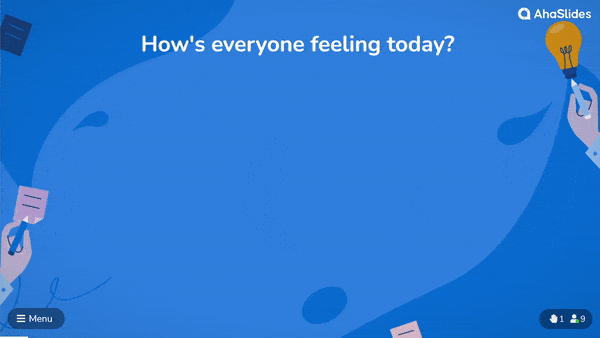
40 Ice Breaker Word Cloud Examples
Need a Word Cloud Sample? Climbers break the ice with pickaxes, facilitators break the ice with word clouds.
The following word cloud examples and ideas offer different ways for employees and students to connect, catch up remotely, motivate each other and solve teambuilding riddles together.
10 Hilariously Controversial Questions
- What TV series is disgustingly overrated?
- What’s your favourite swear word?
- What is the worst pizza topping?
- What’s the most useless Marvel superhero?
- What’s the sexiest accent?
- What’s the best cutlery to use for eating rice?
- What’s the largest acceptable age gap when dating?
- What’s the cleanest pet to own?
- What’s the worst singing competition series?
- What’s the most annoying emoji?

10 remote team catch-up questions
- How are you feeling?
- What is your biggest hurdle with working remotely?
- What communication channels do you prefer?
- What Netflix series have you been watching?
- If you weren’t at home, where would you be?
- What’s your favourite work-from-home item of clothing?
- How many minutes before work starts do you get out of bed?
- What’s a must-have item in your remote office (not your laptop)?
- How do you relax during lunch?
- What have you omitted from your morning routine since going remote?
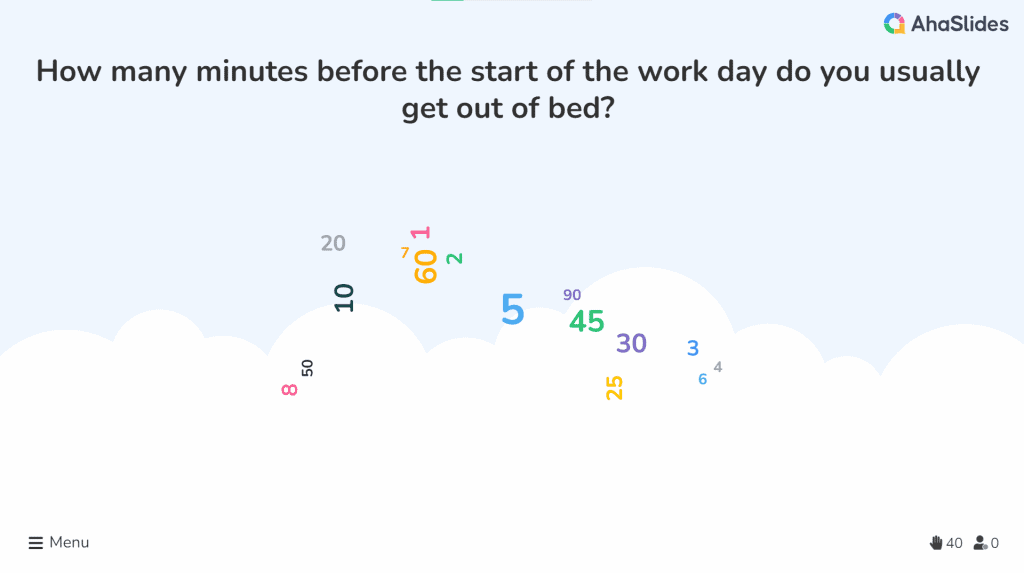
10 motivating questions for students/employees
- Who nailed their work this week?
- Who’s been your main motivator this week?
- Who made you laugh the most this week?
- Who have you spoken with the most outside of work/school?
- Who’s got your vote for employee/student of the month?
- If you had a super tight deadline, who would you turn to for help?
- Who do you think is next in line for my job?
- Who’s the best at dealing with difficult customers/problems?
- Who’s the best at dealing with tech issues?
- Who’s your unsung hero?
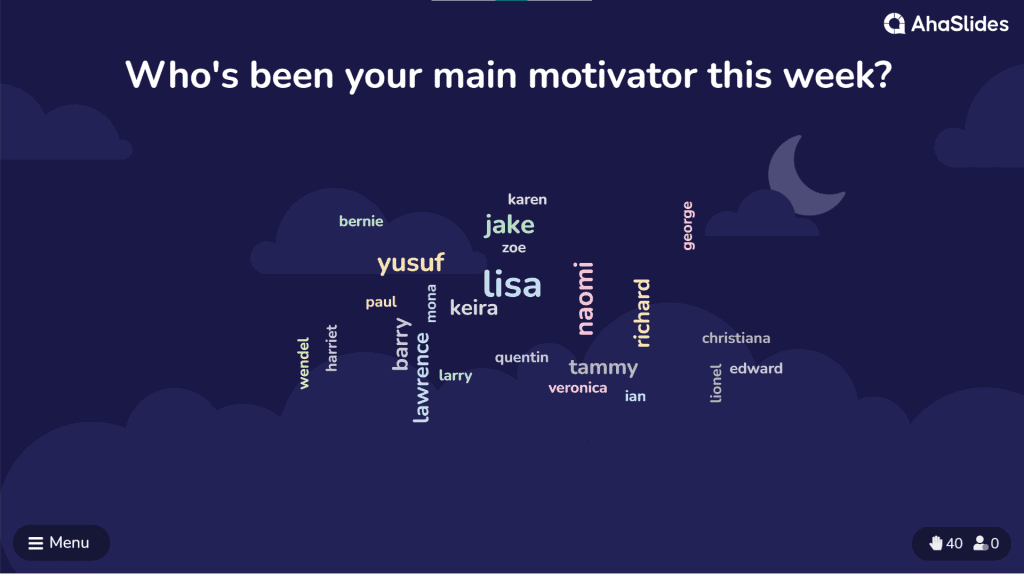
10 team riddles
- What has to be broken before you can use it? Egg
- What has branches but no trunk, roots or leaves? Bank
- What becomes bigger the more you remove from it? Hole
- Where does today come before yesterday? Dictionary
- What kind of band never plays music? Rubber
- What building has the most stories? Library
- If two’s a company, and three’s a crowd, what are four and five? Nine
- What begins with an “e” and only contains one letter? Envelope
- What five-letter word has one left when two are removed? Stone
- What can fill a room but takes up no space? Light (or air)

🧊 Want more icebreaker games to play with your team? Check them out!
40 School Word Cloud Examples
Whether you’re getting to know a new class or letting your students have their say, these word cloud activities for your classroom can illustrate opinions and ignite discussion whenever it’s needed.
10 questions to learn about your students
- What’s your favourite food?
- What’s your favourite genre of movie?
- What’s your favourite subject?
- What’s your least favourite subject?
- What attributes make the perfect teacher?
- What software do you use the most in your learning?
- Give me 3 words to describe yourself.
- What’s your main hobby outside of school?
- Where’s your dream field trip?
- Which friend do you rely on the most in class?
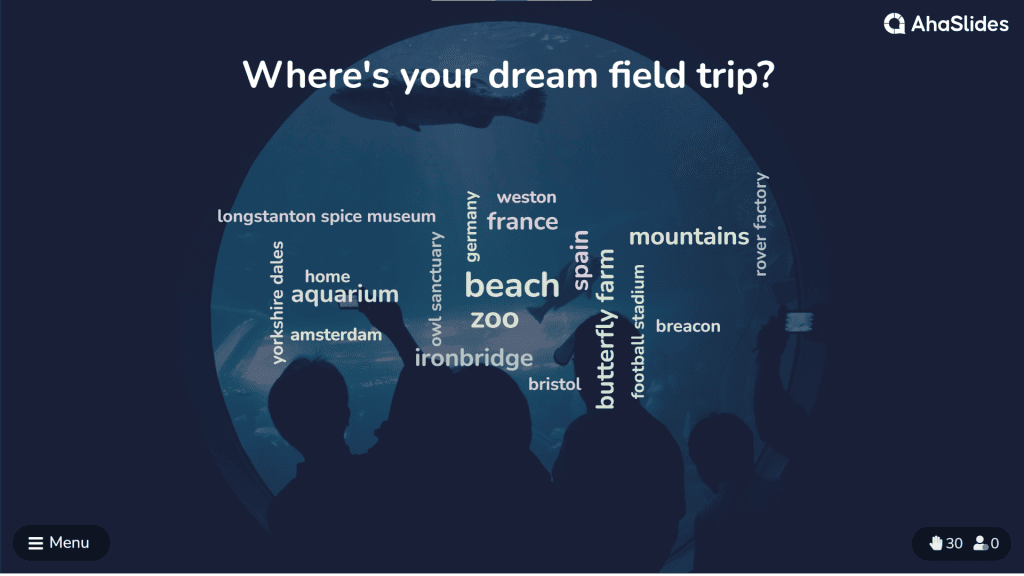
10 end-of-lesson review questions
- What did we learn about today?
- What’s the most interesting topic from today?
- What topic did you find difficult today?
- What would you like to review next lesson?
- Give me one of the keywords from this lesson.
- How did you find the pace of this lesson?
- Which activity did you like the most today?
- How much did you enjoy today’s lesson? Give me a number from 1 – 10.
- What would you like to learn about the next lesson?
- How included did you feel in class today?
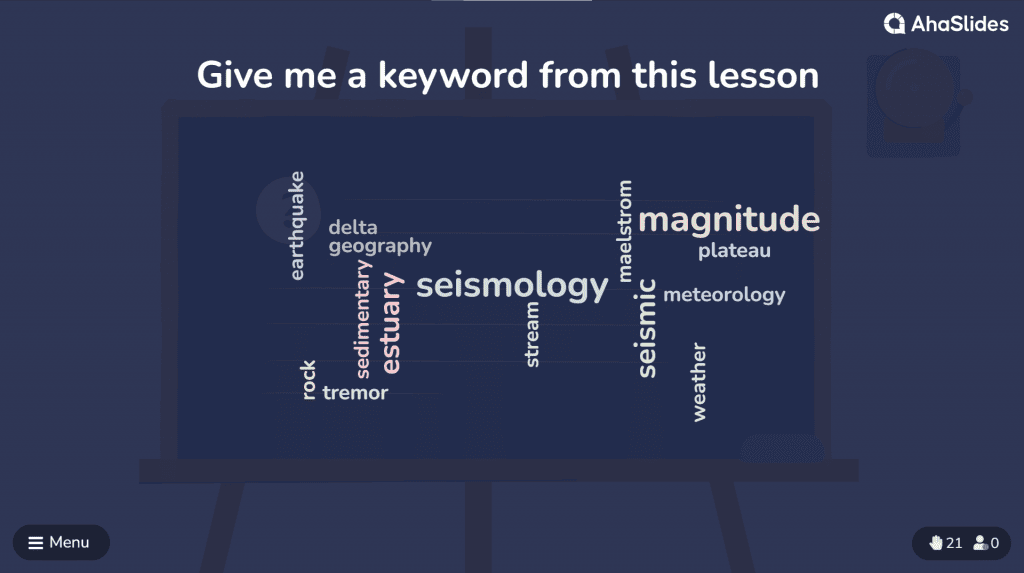
10 virtual learning review questions
- How do you find learning online?
- What’s the best thing about learning online?
- What’s the worst thing about learning online?
- In which room is your computer?
- Do you like your at-home learning environment?
- In your opinion, the perfect online lesson is how many minutes long?
- How do you relax in between your online lessons?
- What’s your favourite software that we use in online lessons?
- How many times do you go outside your house in a day?
- How much do you miss sitting with your classmates?
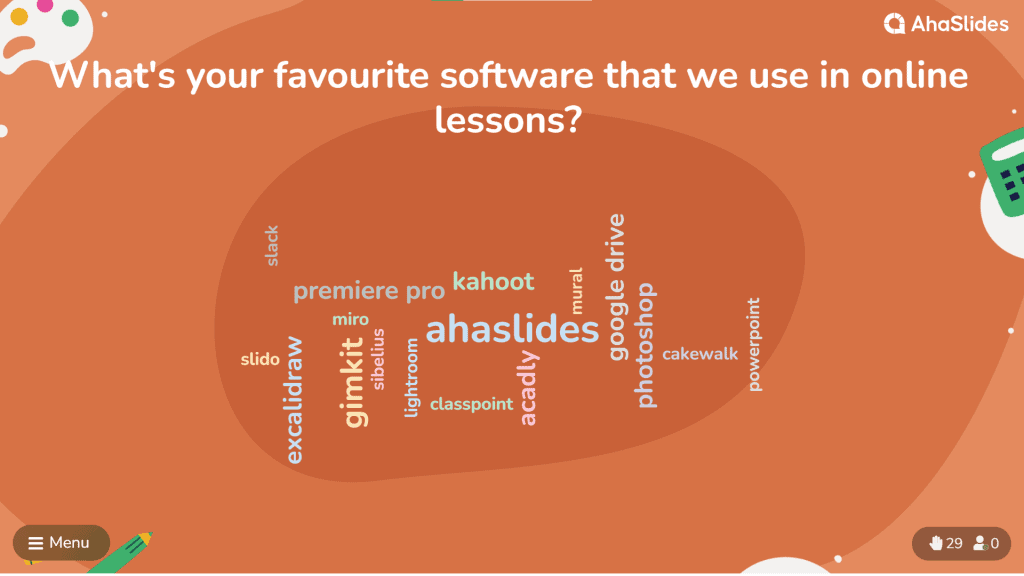
10 book club questions
Note: Questions 77 – 80 are for asking about a specific book in a book club.
- What’s your favourite genre of book?
- What’s your favourite book or series?
- Who’s your favourite author?
- Who’s your favourite book character of all time?
- Which book would you love to see made into a movie?
- Who would be the actor to play your favourite character in a movie?
- What word would you use to describe the main villain of this book?
- If you were in this book, which character would you be?
- Give me a keyword from this book.
- What word would you use to describe the main villain of this book?
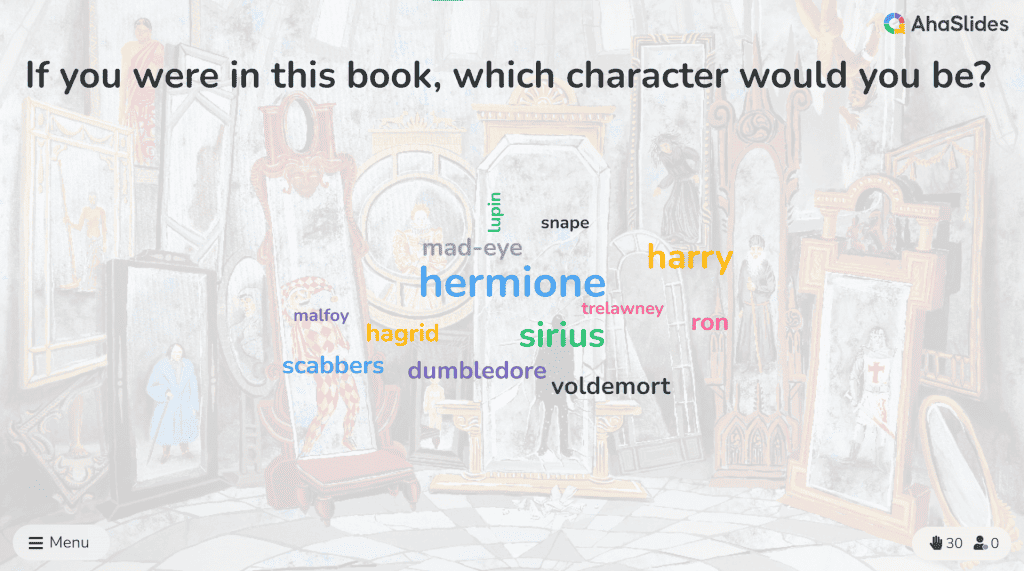
21 Pointless Word Cloud Examples
Explainer: In Pointless, the aim is to get the most obscure correct answer possible. Ask a word cloud question then delete the most popular answers one by one. The winner(s) is whoever submitted a correct answer that no one else submitted 👇
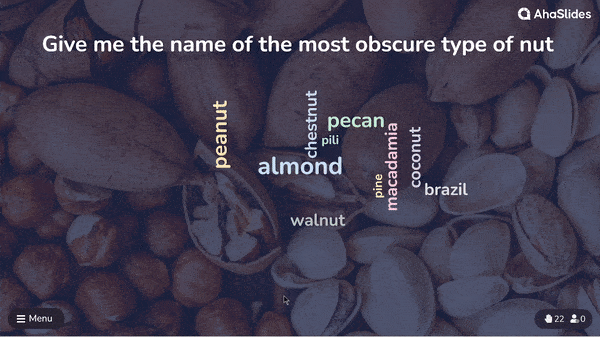
Give me the name of the most obscure…
- … country beginning with ‘B’.
- … Harry Potter character.
- … manager of the England national football team.
- … Roman emperor.
- … war in the 20th century.
- … album by The Beatles.
- … city with a population of over 15 million.
- … fruit with 5 letters in it.
- … a bird that can’t fly.
- … type of nut.
- … impressionist painter.
- … method for cooking an egg.
- … state in America.
- … noble gas.
- … animal beginning with ‘M’.
- … character on Friends.
- … English word with 7 syllables or more.
- … generation 1 Pokémon.
- … Pope in the 21st century.
- … member of the English royal family.
- … luxury car company.
Try it Out!
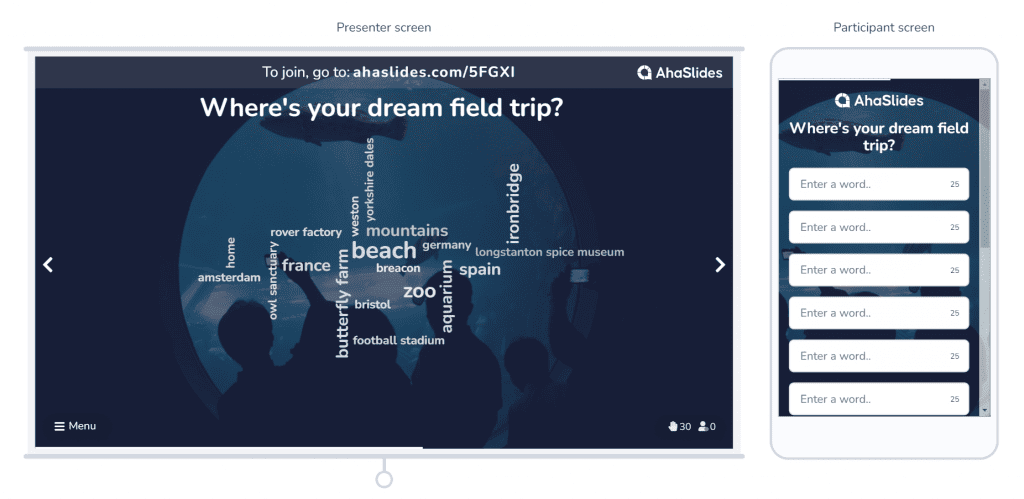
Put these word cloud examples into action. Try a demo to see how our free interactive word cloud works 👇
Best Practices for Word Clouds
If the word cloud examples and ideas above have inspired you to create your own, here are a few quick guidelines to get the most out of your word cloud session.
- Avoid yes/no – Make sure your questions are open-ended. A word cloud with just ‘yes’ and ‘no’ responses is missing the point of a word cloud (it’s better to use a multiple choice slide for yes / no questions.
- More word cloud – discover the best collaborative word cloud tools that can earn you total engagement, wherever you need it. Let’s dive in!
- Keep it short – Phrase your question in a way that encourages just one or two-word responses. Not only do short answers look better in a word cloud, they also lessen the chance that someone will write the same thing in a different way. Learn how to create a word cloud with images to keep it short easily! Or, check out the Powerpoint Word Cloud
- Ask for opinions, not answers – Unless you’re running something like this live word cloud example, it’s always best to use this tool for gathering opinions, rather than assessing knowledge of a certain topic. If you’re looking to assess knowledge then a live quiz is the way to go!
Word clouds are known by a variety of names including wordles, text clouds, and tag clouds. These fantastic graphics can reveal trends and allow you to present ideas, text, and concepts in a way that is eye-catching and compelling for students. Trying to find the right tool? You’ve come to the right place! We’ve put together a list of the best free word cloud generators for teachers.
Why Use Word Clouds in the Classroom?
Word clouds are fun to look at and will get students’ attention. You can take words and turn them into cool images using different shapes, fonts, and color schemes. While you can use a tool to create them for your classroom, students may enjoy making their own with just a piece of paper and some markers.
Here are some suggestions for using word clouds with students:
- Use word clouds as an icebreaker activity (What is was the most fun thing you did over summer break?).
- Activate prior knowledge of a topic.
- Describe book characters, historical figures, famous scientists, etc.
- Brainstorm writing topic ideas.
- Summarize topics to develop an understanding.
- Find the theme for a class discussion.
- Explore the meanings of challenging vocabulary words.
- Use word clouds as an exit ticket to assess understanding and identify gaps in learning.
Depending on which tool you choose, there may be a bit of a learning curve when you start using word clouds in your classroom. But the effort will be worth it in the end!
1. WordArt.com
If you’ve been using word clouds for a while, you may remember that this tool was known as Tagul up until 2017. Rebranded as WordArt.com, this popular and highly customizable free word cloud generator for teachers is widely used in the classroom and even among professional designers.
Try it: WordArt.com
2. WordClouds.com
This user-friendly free online wordle creator can be used on computers, tablets, and smartphones. There are many options for generating and tailoring your word cloud. Need inspiration? Check out their gallery of wordle examples!
Try it: WordClouds.com
3. Word Cloud Maker
You may not have as many settings with Word Cloud Maker as you do with other generators, but the features it does offer are powerful. They have great layouts and shapes you can use to create something that’s truly engaging and unique.
Try it: Word Cloud Maker
4. WordItOut
As with other word cloud generators on this list, WordItOut allows you to create wordles from words, phrases, spreadsheets, and even whole documents. This tool also gives you the ability to embed your creations in your non-commercial blog or website.
Try it: WordItOut
5. WordSift
You’ll have limited options for layouts with WordSift, which only offers five templates, but this is still a great free word cloud generator for teachers. The data visualization is fantastic and you can adjust the colors, font, orientations, and even the scale of words.
Try it: WordSift
6. ABCya
The interface for this word cloud generator is so simple and fun! Once your text has been input, you can easily add effects to your wordle. Want to shake things up? Hit the “randomize” button to instantly change shapes, fonts, and font colors.
Try it: ABCya
7. MonkeyLearn Word Cloud Generator
This AI-powered tool is ideal for the classroom. Using advanced relevance algorithms, it will automatically recognize compound words and collations while removing stop words. The interface is modern, free of ads, and easy to navigate.
Try it: MonkeyLearn
8. TagCrowd
If you’re looking for minimalist word maps, TagCrowd is a great word cloud generator. The tool is very basic, but you still have the ability to adjust settings for languages, word limits, and upper/lower-case letters.
Try it: TagCrowd
9. Jason Davies Word Cloud
This free word cloud generator for teachers allows you to create symmetrical wordles. The interface is incredibly easy to use and generates powerful algorithms so you can make the cool, customized word cloud in seconds.
Try it: Jason Davies Word Cloud
10. EdWordle
It’s easy to create word clouds with EdWordle. Simply add text to create your own or edit existing wordles. You can customize your creations by randomly scrambling words, changing the color and font of individual words, and building “neighborhoods” by having related words appear close to one another.
Try it: EdWordle


